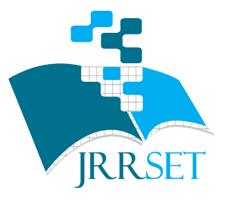(An ISO 9001:2015 certified)


Authors - J. D. Patrishiya Fernando
Abstract : Melmangalam is a small village situated in the bank of Varaha river 5 Kms to the east of Periyakulam, Theni district. The village was adorned with nine inscriptions. In lithic records the village was spotted as “Nithavinotha Chaturvedimangalam”, “Mudivalangu Pandya Chaturvedimangalam”, ‘Chaturveda Sundara Mangalam’. At present it embellished with the name of Melmangalam. Melmangalam is dotted with three ancient temples, Mayapandieswarar Temple dedicated to Siva and another two temples named Ranaganatha Perumal Temple and Naduvittriiruntha Perumal dedicated to Vishnu. In this article a systematic analysis has been made to study deeply on the temples origin and their architectural features.
Keywords : Chaturvedimangalam, Bramadeya, sthalapurana, lithic record, garbagraha, Ardhamandapa, mahamandapa, Mukamandapa, Thirthavaari mandapa, nandi ,Balipitha,Prakara.
Authors - Nafisa Bahaeldin Abdelrhman, Mohammed Yagoub Esmail, Megdi Eltayeb
Abstract : A blind person daily encounters many difficulties such as walking on the road, finding right path. In this project the guide cane comes as a solution to enable them to identify the world around by integrate the traditional white cane with an interface consisting of AT MEGA 8L microcontroller and ultrasonic sensors to detect all obstacles (forward, above knew) and pits ,and water sensor to detect water on the ground. The result of ultrasonic sensors alarm with different ring for each sensor, and vibrations for water in the bath, The result of ultrasonic sensors alarm with different ring for each sensor, and vibrations for water in the bath, all this alarms buzzer will be stopped once it is taken guide cane out from obstacles and water. This can considerably alleviate the risk of the blind people injuring himself. The circuit designed firstly by Proteus Virtual System Modeling then the guide cane was actually assembled which works efficiently 87%.
Keywords : guide cane, ATMEGA 8L, ultrasonic sensor, PTFE
Authors - A.Kalaivani, Dr.A.Jagan
Abstract : Wireless information transmission through the ocean is one of the enabling technologies for the development of future ocean-observation systems and sensor networks. Wireless underwater acoustic networking is the enabling technology for these applications. Underwater Acoustic Sensor Networks (UW-ASN) consist of a variable number of sensors and vehicles that are deployed to perform collaborative monitoring tasks over a given area. To achieve this objective, sensors and vehicles self-organize in an autonomous network which can adapt to the characteristics of the ocean environment. Acoustic communications are the typical physical layer technology in underwater networks. Reliable Underwater Wireless Sensor Networks (UWSNs) can supply good services for deep-water engineering applications operating in the volatile underwater environment. To integrates the AUV’s dynamic path planning algorithms into the routing protocol to an AUV-aided acoustic communication protocol, namely AA-RP (AUV-Aided Routing Method Integrated Path Planning) is used. A part of sensor nodes avoid the Request/Reply mechanism and forward data.With the dynamic AUVs’ path, the GNs are changing dynamically, which can balance energy consumption of the network.The simulation result shows that both End-to-End Delay and energy consumption of the proposed method can get higher performance, compared with some existing routing protocols, such as H2-DAB and the DBR. Also, the PDR of AA-RP is in an acceptable range. The method is able to prolong the lifetime of network and to handle the hot spot and zone problem.
Keywords : Underwater, UW-ASN, UWSN, Acoustic.
Authors - P. Hema Suganthi, K. Subha
Abstract : Currently Mobile Robot has been widely used in examination and navigation particularly where static and unknown surroundings are involved. Path planning is a crucial problem in mobile robotics. Path planning of robot refers to the determination of a path, a robot takes in order to carry out the necessary task with a given set of key parameters. To find best possible path from starting point to target point, that reduces time and distance, in a given environment, avoiding collision with obstacles is a current potential research area. This paper presents SCNN and CNN-MH algorithm to solve the problem of mobile robot path planning such that to reach the target station from source station without collision. The SCNN and CNN-MH algorithm will give the collision free optimal path. The result obtained with CNN-MH was compared with SCNN. The mobile robot environment is treated as a grid based environment in which each grid can be represented by an ordered pair of row number and column number. The mobile robot is considered as a point in the environment, to reduce the computational complexities. The CNN-MH results show better convergence speed and reduction in computational time than that of SCNN through multiple MATLAB experiments.
Keywords : Mobile Robot, Path Planning, SCNN, CNN-MH, Collision free and optimal path

